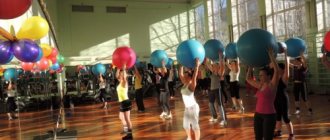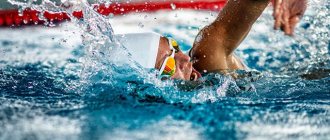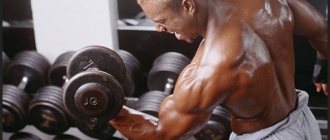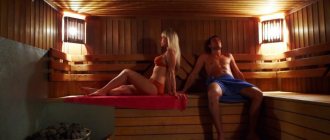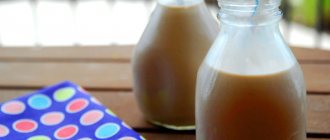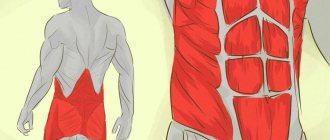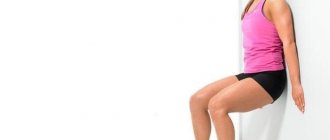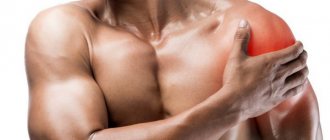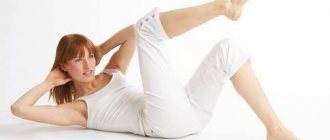Updated 06/23/2020 Training for our body is a lot of stress, which the body is used to dealing with using typical means. That is why, if you get an excessively large load during the training process, you can easily get a number of very unpleasant symptoms: be it nausea or even fever after training. Why does it occur, how to deal with it and most importantly, how to avoid such an unpleasant consequence?
Temperature after exercise
Changes in an athlete's well-being after physical activity are considered common. Aching muscle pain, fatigue, slight chills, and fleeting attacks of nausea have been experienced more than once by all adherents of a healthy lifestyle. Many athletes report a rise in temperature after training in the gym. In most cases, this condition is not associated with inflammatory processes occurring in the body.
Weak exercises, very good load, poor endurance
At rest, about 60-70% of the total blood volume circulates in the human body. The second part is stored in organs and tissues: for example, in the spleen. With a sudden increase in load, blood quickly enters the bloodstream.
The liver enlarges and is pressed into the liver capsule, which is equipped with a large number of nerve endings. The result is the pain of true hypochondria. Pain in the liver. This phenomenon is common among weak smokers, awakened non-smokers (don't forget about the school run: the girls were probably stuck in the right direction after the first round at the stadium).
From time to time, pain appears on the left side - this is how it reacts to a sharp increase in blood volume in the spleen.
- First, be sure to warm up before you start. The purpose of warming is to maintain body heat evenly: to increase blood flow, to prepare muscles (including the muscles of internal organs) for stress. If you do not follow this rule, you will get a sharp release of blood into the vascular bed, which means pain.
- Secondly, start with light loads and short sessions. In the first session, it may only work for 10 to 15 minutes, which is quite common. With the gradual increase in endurance from side pain, you begin to worry.
- Third, as soon as you feel pain, slow down or take a step (just don't stop quickly), relax your shoulders and arms a little and take a deep breath. From time to time, pressure can be applied with 3-4 fingers in the area of pain.
Reasons for increased temperature after exercise
Inexperienced athletes often wonder why the temperature rises and chills appear after training. This phenomenon has objective reasons:
- cardio load that caused an acceleration of metabolism;
- heat loss with sweating;
- stress loads caused by overtraining, muscle micro-tears, the formation of lactic acid, and a decrease in glycogen reserves in the depot;
- feeling unwell shortly before training, flu or ARVI;
- taking medications that affect body thermoregulation;
- increased thyroid function;
- presence of neurogenic hyperthermia;
- increased levels of the hormone prolactin.
Now you know whether your temperature can rise after exercise. Sometimes the rise in the thermometer after physical activity is insignificant and shows 37–37.5 degrees. If the mark has jumped 38 degrees, then take care of your health and come to the gym after a 2-3 day break.
Advice! If you experience severe nausea, headaches, joint pain, high fever or other alarming symptoms, stop exercising immediately.
Is it possible to train with a fever?
It is impossible to answer this question unequivocally - it all depends on the cause of deviations in body thermoregulation. If heat transfer is related to the reasons described above, then there is no need to worry. The athlete needs to achieve cooling of the body to normal levels. To do this, it is recommended to reduce the intensity of exercise, take a break, and drink more fluids. Once your temperature is back to normal, you can continue training.
If the temperature is of a viral or bacterial nature (acute respiratory infections, influenza, ARVI, etc.), then training is strictly prohibited until the athlete has fully recovered.
The benefits and harms of training with a temperature
Some athletes cannot live a day without sports and go to the gym even during illness. Is there any benefit from such a visit, what harm does a person do to a heated body?
In this case, there are no and cannot be any advantages from training. But there are many disadvantages.
Physical activity during inflammatory diseases is fraught with complications on the heart, hypoxia, increased levels of the hormone cortisol, which destroys muscle tissue, and deterioration of the general condition. Can a sick athlete have a fever after training? Yes, the next day after visiting the gym, a weakened body will probably respond by raising the thermometer above 38°.
If the cold is mild, then classes are allowed, but in a lighter form. The athlete needs to avoid sweating and monitor the pulse (maximum 120 beats per minute).
Cool down and stretch
When running, blood flow increases in the loaded muscles, so it is very important to ensure a smooth change in blood circulation at the end of the run.
To do this, each run must be completed with a cool-down - a kilometer and a half of light jogging or a couple of laps on foot around the stadium. Cooling down helps the body return to a “normal” state, gradually slowing down the breathing rate and pulse, and normalizing blood microcirculation.
After your cool-down, it's time to do some post-run stretching. Here, special attention is paid to large muscles such as quadriceps, hamstrings, calves and glutes, chest and back.
Well, then, as we already said, have a good meal!
This is an adaptation and translation of material published in Runners' World magazine. Yulia Shigorina for the translation .
How to avoid fever?
To prevent healthy athletes from developing a fever during training, the following rules must be followed:
- Play sports only if you feel well and are free from any illness.
- Drink more fluids to cool your body through sweating.
- Calculate the intensity of exercise correctly.
- Avoid consuming products containing caffeine.
- Keep a training diary. Simple planning of classes in the gym allows you to control the results and protects you from overtraining.
- During the hot season, exercise outside or in air-conditioned rooms.
- Reduce protein in your diet to reduce the likelihood of inflammation in the liver and kidneys.
- Stop using fat burners.
- Give your body enough time to recover between workouts.
Advice! If a rise in temperature is noted when performing a certain exercise, then replace it with another type of physical activity.
Improper breathing
Improper breathing can also cause pain. For example, if the diaphragm does not receive enough oxygen, cramps occur and the person experiences pain in the upper abdomen.
With shallow and rapid breathing, the path of observation of the diaphragm is very small, because the blood flow to the heart is miniature, and the blood stagnates in the liver, increasing its volume. And far away - the same pain on the right side due to the pressure of the leaking organ on the liver capsule.
Breathing is calculated evenly: two steps - inhale, two - exhale (you can inhale and exhale in 4 steps - depending on the characteristics of the body and the pace of running). Inhale through your nose, exhale through your mouth. If the pain is caused by a spasm in the diaphragm, take a deep breath, insert your lips into the tube and exhale very slowly.
Can the temperature rise after playing sports? Questions
Physical activity involves the production and expenditure of energy. As you know, energy does not disappear anywhere and its excess, not spent on muscle contraction, is released by the body in the form of heat. This in turn leads to an increase in temperature after exercise. If you engage in physical exercise or work, dressed inappropriately for the weather or specially wrapped in cellophane (many people often use this technique when losing weight), then an increase in body temperature is guaranteed. Under normal conditions, an increase in temperature during prolonged training or hard work is normal. What reasons cause body temperature to rise under other circumstances?
Why does the temperature rise after exercise?
- Often, the temperature after physical activity increases in inexperienced novice athletes who, in an effort to give maximum stress to their body, overexert themselves and lead the body to a state of stress. In this case, it is advisable to exercise under the guidance of a trainer who will adjust the load.
- With increased thyroid function, even mild physical activity can lead to an increase in temperature. At the same time, sweating, hand tremors and irritability are observed against the background of an enlarged thyroid gland. By contacting an endocrinologist, performing an ultrasound of the thyroid gland and determining the level of its hormones (T3, T4, TSH), it will be possible to confirm or refute hyperthyroidism and select treatment.
- High levels of the hormone prolactin, produced by the brain, can also provoke low-grade fever during exercise. Blood can be tested for prolactin in any clinical laboratory. At the same time, an x-ray of the sella turcica is prescribed.
- An increase in temperature after physical activity is observed if a person becomes ill with an infectious process (for example, ARVI). In this case, the load simply accelerates the development of the body's response to contact with infection.
- Neurogenic hyperthermia is a temperature reaction due to an imbalance of the autonomic nervous system. Increases in temperature can provoke not only physical activity, but also emotional excitement.
Prevention of leg pain
Pay attention to your diet. Make sure you eat foods that contain potassium and calcium. These are bananas, dried apricots, almonds, mustard, pistachios, beans, peas, oatmeal, lentils, potatoes, walnuts, prunes, tusk. These microelements stretch bones and promote rapid muscle regeneration. To drink a lot of water.
From time to time, specific dehydration becomes an inevitable condition for leg pain. People often forget this important water, which leads to unpleasant results.
Make sure your shoes are suitable for running. This is especially important if classes are held on hard surfaces. Shock-absorbing sole. If it is very narrow, you can seriously damage your joints.
How to avoid?
To achieve athletic progress, it is important not only to understand why the temperature rises after training, but also to know how to avoid such a situation.
- Drink more fluids during your workout. More fluid means more sweating and less chance of fever.
- Reduce your caffeine intake before exercise.
- Do not use fat burning drugs.
- Keep a training diary. It helps you avoid overtraining.
- Reduce physical activity during exercise.
- Recover fully between workouts. This will reduce the negative training stress factor
- Reduce your protein intake. This will help if you significantly exceed the recommended doses, which leads to inflammatory processes in the liver and kidneys.
What to do if your temperature rises after training?
CrossFit is considered one of the most challenging sports for the majority of the population. Phrases like “nausea occurs after training” are often heard in the community or complaints about chronic overtraining of the body are heard. But such an aspect as temperature after training is practically not considered, since such a symptom is considered almost the norm. Is it so? Let's consider this issue in detail.
Why does it happen?
Can you have a fever after exercise? If it goes up, is that bad or normal? To answer these questions, it is necessary to study the entire complex of processes occurring in the body during training.
Acceleration of metabolism
In the process of working with a projectile, we make many more movements than in everyday life. All this leads to acceleration of the heart and acceleration of metabolism. The increased speed of the main processes leads to a slight increase in temperature.
Heat release
During training, to perform certain actions (lifting a barbell, running on a track), we need a huge amount of energy, which is released from nutrients. Burning of nutrients always occurs with the release of heat, which is regulated by additional sweating. But the body continues to burn nutrients after exercise, which can lead to a slight increase in temperature during the recovery period.
Stress
Training itself is a destructive factor. The effort during exercise physically breaks our muscle tissue, forcing all systems to work to the limit. All this leads to stress, which can lead to weakened immunity. If the loads were excessive, or the body was fighting an infection in the background, then an increase in temperature is a consequence of a weakening of the body.
The influence of third-party drugs
Modern people consume a huge number of different additives. This includes fat burning complexes. Starting with innocent L-carnitine and ending with killer drugs that increase performance during training.
Almost all fat burning and pre-workout supplements aimed at burning fat as the main fuel can affect body temperature. This can be done in two ways:
- Increase your basal metabolic rate. In fact, this increases the temperature to 37.2, as a result of which the body tries to return to a balanced state, for which it spends a lot of energy (including fat).
- Transition to fat depot by increasing the load on the cardiac muscle group.
In both the first and second cases, triglycerides are used as an energy source, which, when burned, release 8 kcal per g versus 3.5 kcal per g obtained from glycogen. Naturally, the body is physically unable to process such a volume of energy at once, which leads to additional heat transfer. Hence the effect of increasing body temperature after and after exercise.
In most cases, individually, all of these factors cannot seriously change body temperature, but together, in some people they can cause a significant increase, up to 38 degrees and above.
Wrong breakfast
Immediately after eating, the body makes every effort to digest. The stomach is enlarged and works with fermentation and grinding. The liver is actively involved in neutralizing toxins, blood vessels are dilated.
The heavier the food, the more the gastrointestinal tract must work. Compulsion leads to increased blood flow, which increases the already large number of organs. The result is the same - pain on the right side.
- First, eat breakfast at least 40 minutes before you start driving. If breakfast was close, the time should be extended to 1-1.5 hours.
- Secondly, do not eat too much: fatty, fried, ground, smoked. Give preference to fermented milk products, light salads, boiled rice, and cereals.
- Third, vary the intensity of the hour. If you feel like your stomach is still working for breakfast, skip the samples to get full strength.
Is it possible to train with a fever?
It all depends on why you have a fever after exercise. If this is a condition associated with a weakened immune system, then training is strictly not recommended, since training is an additional stress for the body. Like any stress, it has a temporary depressing effect on the body, which can lead to an exacerbation of the disease.
If you are shivering from overload in the body, then you need to pay attention not only to the level of stress and temperature, but also to the complex of drugs that you use.
In particular, an increase in temperature may be a consequence of:
- taking a pre-workout complex;
- caffeine intoxication;
- effect of fat burning drugs.
In this case, you can train, but avoid a serious strength base. Instead, it is better to devote your training to aerobic complexes and serious cardio exercise. In any case, before your next workout, reduce the dosage of the supplements you use to reduce the occurrence of negative side effects.
If we are talking about a slight rise in temperature (from 36.6 to 37.1-37.2), then this is most likely only a thermal effect from the resulting load. To reduce the temperature in this case, it is enough to increase the amount of fluid consumed between approaches.
Results
Can the temperature rise after training, and if it does, will this be a critical factor? If you measure your temperature 5-10 minutes after exercise, there is nothing to worry about a slight increase in readings. But if the temperature starts to rise later, this is already a signal from the body about overload.
Try reducing the intensity of your workouts or giving up fat-burning complexes. If the increase in temperature after training the next day becomes constant, you should consider completely reconsidering your training complex or even consult a doctor.
Training for our body is a lot of stress, which the body is used to dealing with using typical means. That is why, if you get an excessively large load during the training process, you can easily get a number of very unpleasant symptoms: be it nausea or even fever after training. Why does it occur, how to deal with it and most importantly, how to avoid such an unpleasant consequence?
How to avoid?
To achieve athletic progress, it is important not only to understand why the temperature rises after training, but also to know how to avoid such a situation.
- Drink more fluids during your workout. More fluid means more sweating and less chance of fever.
- Reduce your caffeine intake before exercise.
- Do not use fat burning drugs.
- Keep a training diary. It helps you avoid overtraining.
- Reduce physical activity during exercise.
- Recover fully between workouts. This will reduce the negative training stress factor
- Reduce your protein intake. This will help if you significantly exceed the recommended doses, which leads to inflammatory processes in the liver and kidneys.
Why does it happen?
For many, it will be interesting to know not only why the temperature rises after exercise, but also how to avoid the harmful consequences of this protective reaction of the body. To do this, it is important to understand the general biochemical processes that occur in our body during heavy loads. The body is a very lazy and closed system that strives to be in constant balance. Any movement and lifting of weights is a serious stress for him, which he can deal with in two ways:
- Adaptation. The body launches anabolic processes that allow you to build muscle mass, and, therefore, become stronger, faster, and more resilient. Adaptation starts when the stress for the body is not very great and it is able to cope with it using internal resources.
- Optimization. The body launches processes that, in its opinion, can help avoid such stress in the future. Optimization is triggered if the load is excessive, and the body is not able to adapt to it at the current metabolic level.
An increase in temperature is a consequence of the launch of short-term optimization processes, which can then turn into adaptation processes. An increase in temperature can be caused by:
- Initially, feeling unwell before training.
- Acceleration of metabolism caused by cardio exercise.
- Stressful loads on the verge of overtraining.
- The release of heat as a means of thermoregulation followed by sweating.
- Taking third-party medications that affect the body’s thermoregulation.
Stress
Stress is the main factor why a temperature of 38 occurs, it can start to shiver right during training and other unpleasant factors, including nausea. The protective reaction against stress is the main regulator of the body's optimization resources. Any serious training load causes:
- Micro tears in muscle tissue;
- Sharp depletion of glycogen reserves in the depot;
- Formation of lactic acid.
And, of course, we must not forget about such an important factor as liver overload during training. Any of these factors is inflammatory for our body. In the process of micro-tears, the body is forced to fill the damaged areas with red blood cells, and drive lactic acid through the entire bloodstream system, causing intoxication. As a result, to combat these negative factors, the body increases body temperature, up to critical levels above 37 and 38 degrees.
Heat release
Another important factor that can cause the body to overheat directly during exercise is the processes of energy release. The fact is that the body cannot use glycogen in its pure form. To do this, he needs to break it down into glucose. Glucose is subsequently broken down into energy itself. The efficiency of our body is not ideal, as is the rate of breakdown of glucose. Therefore, the excess energy obtained as a result of its emergency release naturally turns into heat.
Acceleration of metabolism
Can the temperature rise after training without overtraining and stressful situations? Yes, and this is the third main factor why it is rising. During the training process, our heart, in order to ensure the normal functioning of the entire body, accelerates 2-3 times relative to its resting state. All this leads to the fact that blood begins to circulate faster throughout the body and all processes also occur faster. The result is the release of more thermal energy and an increase in temperature during exercise.
Symptoms of Overtraining
We have already said that the temperature after training can rise as a result of using excessive loads.
In this situation, if you continue to use the same loads, there is a high risk of ending up in a state of overtraining. Many bodybuilders are sure that only professionals can overtrain, but they are the ones who can properly dose the load. Another thing is for beginner athletes who want to get positive results in a short time, and are confident that heavy loads will help them with this. In order to continually progress, you need to not only train hard, but also give your body enough time to recover. This suggests that you should avoid overtraining and now we will look at the most obvious symptoms of this condition.
- The pleasure of training disappears.
If you suddenly don’t feel like exercising, then this is the first symptom of overtraining. On the other hand, this symptom can be considered very subjective, because it is possible that you are simply lazy. - You feel a loss of strength.
Now we are talking about a situation where you are really so tired that you cannot continue to train. This immediately affects your athletic performance and the previous weights of sports equipment suddenly become too heavy for you or you cannot run at the same speed. - Irritability increased and a feeling of depression appeared.
When these symptoms appear, it is necessary to correctly determine their nature. It is quite possible that it is all about problems with family or at work. If you feel better after completing the training, then it’s not a matter of overtraining. But when the situation worsens after class, you should reconsider your loads. - Sleep patterns are disrupted.
This symptom can manifest itself not only in the form of insomnia, but also in an excessive desire to sleep. If the process of waking up for work or training has become a real torture for you, the likelihood of overtraining is extremely high. - Stopping progress or decreasing athletic performance.
It is to track this process that the training diary is intended. Of course, a training plateau can be caused by other reasons, for example, errors in the training program. But when this symptom appears along with others, it is worth giving the body a couple of days of rest. - Headache.
Painful sensations appear for no apparent reason in the morning or evening. In such a situation, you will have to analyze your condition and if you have other symptoms described today, you should rest. At the same time, if you have severe headaches, you should visit a doctor, because they can be a symptom of various diseases, and not just overtraining. - Interest in sex has decreased and appetite decreases.
If you think that a poor appetite will help you get rid of excess weight, and a decrease in interest in sex indicates your spiritual enlightenment, then this is a delusion. Food and sex are basic instincts for humans, and no matter the level of civilization, these needs cannot be ignored. - Tachycardia appeared.
An increase in heart rate is one of the most objective symptoms of overtraining. If your heart rate is elevated in the morning, and also exceeds the usual levels when using previous physical activity, then you probably need rest. - Muscle pain is felt constantly.
Surely you are already accustomed to the burning sensation in your muscles after exercise and do not pay attention to it. However, if aching pains and aches haunt you constantly and do not give you the opportunity to relax, then this is a wake-up call. - Reduced protective capabilities of the body.
In order for the body to activate regenerative reactions after training, it needs a large amount of amines. These same substances are also used by the immune system. With overtraining, most of the amine reserves are used for recovery after training and, as a result, the immune system cannot do its job efficiently. This leads to the development of various diseases that you cannot get rid of.
Is it possible to train with a fever?
It is impossible to answer this question unequivocally. If the temperature is a consequence of the factors described above, then care must be taken to ensure that it does not rise further. To do this, first of all, it is necessary to reduce the intensity of the workout, and then, if the temperature does not subside, stop it completely until complete recovery.
If a rise in temperature occurs during running and other cardio exercises, then all you need to do is drink as much fluid as possible. If the temperature does not subside the next day, then any physical activity should be avoided until complete recovery.
To summarize
When answering the question whether there can be a temperature after training, you need to understand that the temperature itself is not a problem - it is only a symptom of one of the reasons described above why it may increase. First of all, you need to measure the temperature itself, understand how intensely you trained, and did you come to the training session healthy to begin with?
If the reason is overtraining, then appropriate conclusions need to be drawn from this. If this is a normal reaction to cardio exercise, then it is enough to drink more fluid during the workout itself.
How to avoid?
It is impossible to give universal advice on how to avoid fever, since the causes and reactions of the body to various stresses differ from person to person. However, there are a number of simple recommendations that will help avoid fever.
- Drink more fluids. Water has a high heat capacity, therefore, it can quickly cool our body through sweat.
- Keep a training diary. It helps you control your results and, accordingly, avoid overtraining.
- In the summer, try to train outdoors or in an air-conditioned room.
- Do not come to training if you feel unwell.
